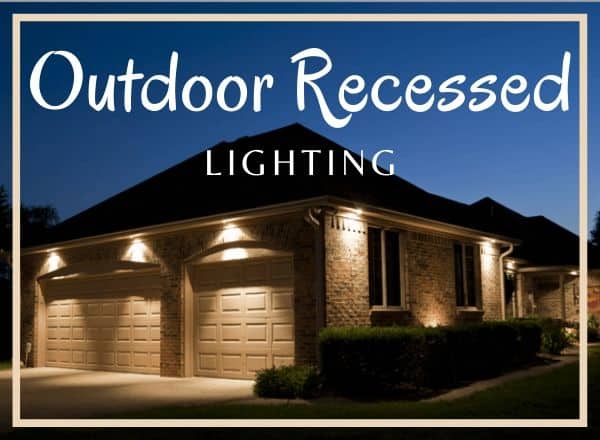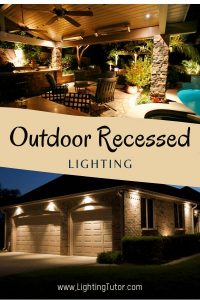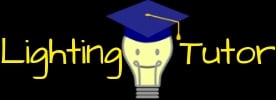Last Updated on April 27, 2020 by The Tutor
Outdoor Recessed Lighting

Recessed lighting is not just for inside of the home. If used effectively, outdoor recessed lighting can be an amazing way to provide lighting for visual effect as well as home security.
If you are considering various ways to light the exterior of your home, outdoor recessed lighting may be a great option for you. We will discuss various types of outdoor lighting, the applications and also installation.
Installing Outdoor Recessed Lighting
Installing outdoor recessed lighting is easiest when the home is still in the construction phase. It allows plenty of access to the location where the lights will be placed and usually an unobstructed way to wire the lights to the power supply and switches.
If you would like to add outdoor recessed lighting to an existing home, this will take lots of planning and some knowledge on how to snake wires. Of course, you could always hire a professional and just let the electrician figure all of that out for you.
Installation Location Options
When it comes to outdoor recessed lighting, most people do not realize how many different places this type of lighting can be added. Once you see some of the options referenced below, you will start thinking about your own home and where you may be able to use outdoor recessed lighting to bring a new look and feel to the exterior of your home.
Porch Ceiling – The porch ceiling is one of the most common places where outdoor recessed lighting is utilized. Why just rely on the light over or next to your door? You can illuminate your porch effectively with recessed lighting the same way you would for your family room. When looking at your home from the road, your porch would now have that even lighting throughout.
Soffits – Adding recessed lighting to the soffits is extremely popular especially when used with low output accent lighting. When added to the soffits this type of lighting is typically there to provide a look and feel and also for some security purposes.
In ground – Yes lighting can also be recessed into the ground. This is often tied into your landscape lighting and buried in some mulch, between shrubs and other strategic locations around the home. We often see smaller recessed lights used along the path leading to a front door.
In decking – You can add small recessed lights in your decking. This is often done around the stairs, posts or railings. This is another great way to bring that added element of light to what may be a dark and boring area of your home at night.
Wall mounted on exterior walls – Outdoor recessed lighting can also be mounted on the exterior walls of your home shining light on a specific area. We see this done a lot on stone walls around the pool or also along the walkway leading up to a home.
New Construction Installation 
When the home is in the construction phase, this is the best time to design your lighting. You will have unfinished walls, ceilings and soffits where it would be much easier to run wires and plan switch locations. For this, all it will take is some creativity and deciding what you want to do. Of course every project also costs money but doing it now will save on installation costs later.
Remodel in Existing Homes
When adding recessed outdoor lighting to existing homes, the planning process will be considerably longer. This is especially true if you are planning to tackle the project yourself. As a novice who may take on this project, you will need to locate a power source, determine where your switches will be, or even tap into an existing switch that may be controlling an exterior light.
Shallow Clearances
When thinking about the various outdoor recessed lighting options, you will need to know whether you have shallow clearances. Traditional recessed lighting fixtures have anywhere from 8-10 inches of clearance directly above the ceiling. However, many porches and soffits do not have that much room up above.
You will need to know how much clearance you have before purchasing the fixtures. If you are unable to make that determination, then you would likely have to make the safe decision by purchasing slim recessed lighting fixtures. These are more expensive but they do not take up as much room.
Wiring Outdoor Recessed Lighting
Wiring outdoor recessed lighting in some instances can be done by removing soffits and or accessing some of these areas from within your attic. You can snake wires in places that are simply different than what you may find in an interior room.
You should read the instructions and ratings that come with the fixtures you plan to purchase. You will likely have to use 14 gauge wire for the typical recessed lighting fixtures.
Wiring Direct from The Panel
If you are unable to tap directly into an existing circuit, or if the fixtures you are adding are too much for the existing circuit to handle the incremental load, you may need to run a dedicated line from the panel.
If you are not comfortable or a novice in working with electricity, you may want to hire an electrician here. Either way, you should check with the local building codes to see what permits may or may not be needed to complete the project.
IC Rated Housings
IC rated housings are meant for “insulation contact”. That is where the “IC” comes from. IC rated housings were created because halogen and incandescent bulbs burned very hot and in turn would make the housing hot. When the housing came in contact with insulation, it created a fire risk.
For some applications, you may have insulation directly above the area where the recessed lights will be installed. You should understand this if your fixtures require an independent housing. Meanwhile, today’s LED bulbs are much cooler and likely would not create a fire hazard.
Damp Rated Outdoor Recessed Lighting Fixtures
If you are installing lights in the exterior of your home, you should at minimum be using damp rated fixtures. Some people confuse damp rated with wet rated lighting applications. Here are the differences between the two:
- Damp rated fixtures – Are exposed to the damp elements but do not come in direct contact with water. This could be lighting that is outside but protected by a soffit or porch.
- We rated fixtures – Are directly exposed to water. This could be the recessed lighting in your shower that can get splashed. It also could be recessed lighting you put in the ground along your front walkway.
If you are installing outdoor recessed lighting, make sure the fixtures you purchase have the correct rating based upon where you plan to install them.
Outdoor Recessed Light Bulbs
In most instances, you will be purchasing a fixture that has the bulb contained within and that fixture will be at least damp rated. However, if you are installing an independent light bulb and trim kit to go with it, then you will need to purchase a bulb that can be used outside.
You can read our article on purchasing the right light bulb for every room. There we will give you an idea on how to shop for light bulbs. You will need to understand how important the kelvin temperature is when it comes to selecting a light bulb too because that can change the look and feel of the outside of your home too.
Low Voltage Recessed Lighting Applications
You may want to consider low voltage lighting to handle all of your exterior lighting including your outdoor recessed lighting. This is not uncommon to tie in your landscape lighting with the recessed lighting beneath your porch and soffits.
You can control all of your exterior lights using a low voltage transformer that can operate on a switch or with a light sensor. Then, once the sun goes down all of your exterior lighting will turn on. This would include the landscape lighting as well as the recessed lighting.
Consider low voltage LED lighting as a serious option because the wiring is easier to deal with and you likely do not need permits or an electrician. Once again, just running the wires will be the most difficult part of the project.
Trim and Reflector Selection
Without spending too much time talking about trim and reflectors, all you need to know is there are hundreds of options. In my experience, you will spend more time picking out the trim and design than you will figuring out the layout and wiring plan.
What you may find is some of the nicer looking options likely will available through lighting companies versus Amazon. Take a look at just photos online and see what you like.
Pros and Cons of Outdoor Recessed Lighting
We love the idea of installing recessed lighting outside. It no doubt will bring a great new element to your home at night. Below are the pros and cons or advantages and disadvantages of outdoor recessed lighting.
Pros
-
- Perfect ambient lighting
- Inexpensive
- Energy efficient
- Can be low voltage
- Can work with timers or light sensors
Cons
-
- Can be challenging to install in existing homes
- Difficult to be moved once installed
- You can see the pros far outweigh the cons when it comes to outdoor recessed lighting
Related Questions
How to determine if a recessed light is rated for outdoor use?
Every light fixture will have a rating that should be listed on the package or in the description. If you are unsure, then contact the manufacturer.
Can recessed lighting be used in wet locations?
Outdoor recessed lighting can be used in wet or damp locations. Make sure you are purchasing a wet rated fixture and follow the installation instructions for that perfect seal.
Are there square outdoor recessed lights?
Square outdoor recessed lights are becoming very popular and look great even when installed in decks.
What are flush mounted porch lights?
Flush mounted porch lights are essentially recessed lights.
Are there canless recessed lights?
Some recessed lighting fixtures come with their own housing and wiring and do not require a special can to be installed. These are very efficient compact units.
How to you replace recessed lighting outside?
Replacing existing recessed lighting is fairly easy. You simply determine whether the existing wiring is appropriate for your new recessed lighting fixtures, then shop for lighting and trim that may fit the recessed lighting cans that already exist. If they are older cans and are not damp rated, then you may want to replace those as well.
How to you keep wasps out of recessed lights?
Recessed lights can be a place where bugs and even wasps find a way in to create nests. If you install the fixtures and trim correctly, you should not have problems with wasps. If the trim does not fit snugly then consider replacing it or sealing the edges with caulk.
Related Articles
How to Layout Recessed Lighting
How to Install Recessed Lighting
